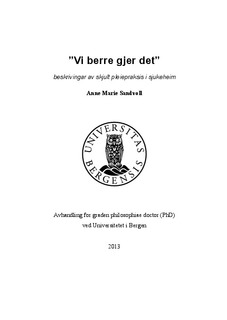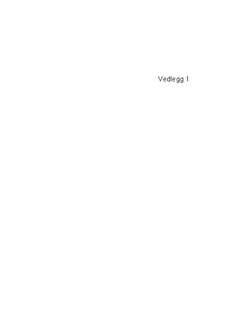| dc.description.abstract | Nursing home practice is often described as complex, even though it might be
regarded as consisting of common, everyday activities. Research indicates that
nursing staff consider assisting nursing home patients to be difficult and demanding
work. At the same time, new regulations are issued for improving quality in nursing
homes. Further, nursing staff acts according to a practical sense, and when asked to
describe the rules under which they act, they are unable to do so. Research is required
to understand the patterns of care that are unspoken and taken for granted. The aim of
this project was to uncover, explore and describe some characteristics of the implicit
aspects of care practice in nursing homes.
An ethnographic design was selected for this study in order to allow an in-depth
understanding of nursing practice in nursing homes. Data were collected in two
nursing homes and were comprised of observations of the staff providing care in two
nursing homes, document analyses and interviews. The findings show that the
nursing staff always seemed to know what to do, and that they knew the residents
well. Findings indicate that the staff knew little about the new quality regulations, and
that the quality of their work was guided by other factors rooted in their established
nursing practice. Further analyses revealed that the staff appeared to be committed to
daily routines in their daily work. In addition, the staff had to deal daily with several
unexpected events, and always seemed to know what to do. Further unexpected
events are described and explored. A seemingly ordinary but unexpected event
develops in to a chaotic situation. This was unusual, but with further investigation
and in the light of theory, the study illustrates the complexity of nursing home
practice. The findings also showed that close contact with some residents’ behaviours
could evoke difficult emotions in the staff, such as irritation and aversion. However,
it was difficult for the staff to admit to these feelings. In spite of this, nursing staff
seemed to believe that they simply had to manage their responses and offer good care
to all residents. The nursing staff had developed a habitus of caring, and their own
statement “we just do it” is a suitable description of how these implicit parts are just being done.
Theoretical frameworks contributed to making sense of the data and gaining a new
understanding of these unarticulated issues in nursing home practice. Bourdieu’s
concept of habitus was useful when trying to understand how the staff seemed
automatically to know what to do. Habitus regulates actions without being a product
of rules; it makes a group of people act as though “collectively orchestrated without
the action of a conductor”. Further, Douglas’ concept of “dirt as a matter out of
place” was used in trying to gain an understanding of the nursing staff’s reactions to
pollution. According to Douglas, dirt is systematically classified and involves the
rejection of inappropriate elements.
The aim of this project was to uncover, explore and describe some characteristics of
the implicit aspects of care practice in nursing homes. The nursing staff’s own
statement, “we just do it”, is a suitable description of how these implicit parts,
existing of both knowledge and experience, are just being done. The nursing staff
performs the care automatically, and at the same time they deal with dirt and
unpleasant tasks, because they are committed to the residents. In the thesis, this is
called habitus of caring. The nursing staff has developed a habitus of caring which
consists of; knowing the residents, commitment to routines, unexpected events, dirt,
as well as unpleasant behaviours that evoke difficult emotions. By exploring and
describing the practice, in light of the concept of habitus from Bourdieu and “dirt as a
matter out of place” from Douglas, the analyses have contributed to extend our
understanding of some unarticulated aspects of nursing home practice. | nb_NO |

